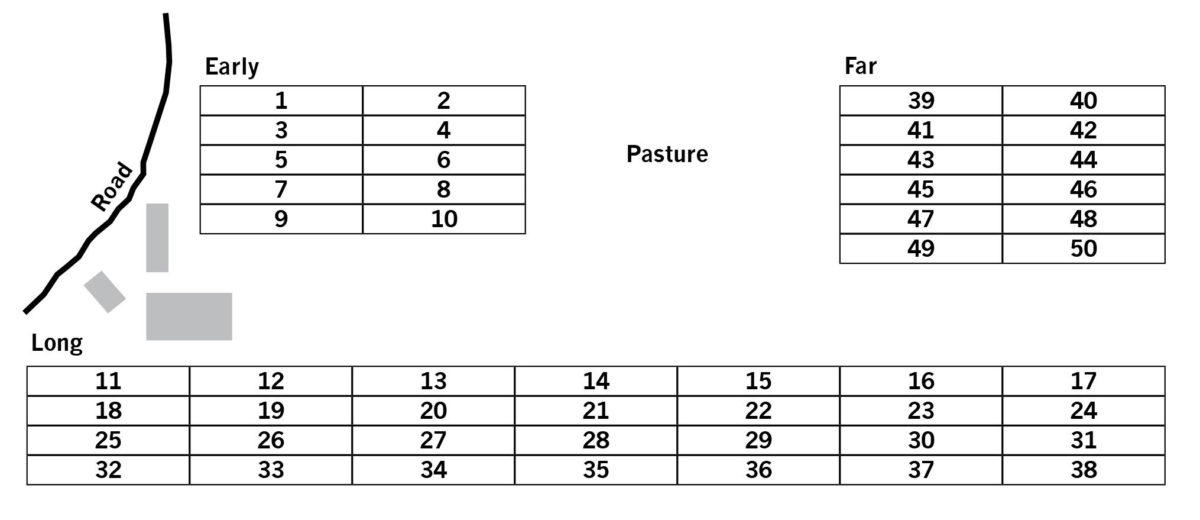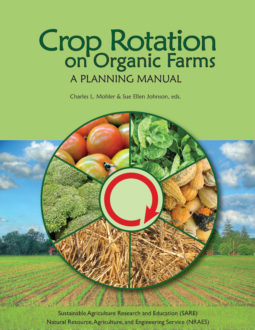A More Complex Example: Summer Acres Vegetable Farm
Table 5.9 shows the Crop Characteristics Worktable for Summer Acres Farm, and figure 5.4 shows a map of the farm divided into management units. Table 5.10 (PDF download) gives completed Field Conditions and Field Futures Worktables. The example is fictitious, but it is based on a sample crop mix and planting and harvest times provided by a New York vegetable grower.

This sample farm is sufficiently land limited to constrain the cropping sequences but not so land limited as to force a serious departure from good rotation practices. The farmers grow 51 management units of cash crops on 50 MUs of land, so some double cropping is necessary.
Because of the land area constraint, the farmers’ primary rotation goal is to maximize the time between crops in the same or similar families. Within this constraint, they choose sequences that supply cover crop nitrogen whenever possible, especially before heavy-feeding crops. The farmers attempt to keep the ground covered with a cash or cover crop throughout the year to prevent erosion and improve soil quality, even when the opportunity for biomass production by a cover crop is limited. The exception is that they include a one-month fallow period in late spring or early summer for weed control whenever this is convenient.
“The farmers attempt to keep the ground covered with a cash or cover crop throughout the year to prevent erosion and improve soil quality...”
Mostly, the Summer Acres farmers manage to plant a given crop in adjacent MUs. However, since they grow most crops in even numbers of MUs, the configuration of the “Long” field in figure 5.4, with its strips of seven MUs, poses a problem. If they cannot manage to plant the same crop in a long strip, they try to plant pairs of MUs that are side by side. This reduces time spent planting and managing the crop. Pepper, tomato, summer squash, and winter squash are less bothersome to have in multiple locations since the farmers grow several varieties of each of these crops. To the extent possible, they attempt to separate successive plantings of lettuce and spinach with one or more MUs of other crops. When successive plantings are forced onto adjacent MUs by other considerations, they try to provide a time lag within the season, so that insect pests and diseases cannot easily spread from one planting to the next.
Before the planning process, the growers often double-cropped short-season crops (for example, an early lettuce planting with a late spinach planting). This allowed them to produce 51 MUs of crops on 50 MUs of land. It also allowed them to plant a soil-building full-season cover crop of oat (mowed in June) and red clover on a few MUs each year. However, it made including shorter-season legume cover crops like cowpea and field pea difficult on an even greater number of MUs, thereby requiring substantial use of compost to meet N needs. Consequently, this practice was discontinued. In order to continue to grow more MUs of crops than they have land, they began intercropping early lettuce or spinach with tomato (see chapter 7). The lettuce or spinach is planted at the same time as the tomato in an adjacent row on the same bed and is harvested in early summer before the tomatoes crowd it. Although double-cropping and intercropping allow intensive use of the land, they also mean that more different crop families are grown within a given number of years on those MUs. This can increase the difficulty of separating families in time.
The only MUs with special properties are in the field called “Early.” That field is well drained and has a south-facing slope that warms early in the spring. Consequently, the farmers attempt to grow their earliest crops on this field whenever possible. These crops include pea, carrot, kohlrabi, and early plantings of lettuce and spinach. Since kohlrabi requires only one MU, whereas the other early crops use two or four MUs, the farmers sometimes use the first planting of beet (beet5 in tables 5.9 and 5.10, PDF download), which also requires only one MU, as a “fill-in” crop to balance the rotation plan. When possible, they also like to grow peppers on the field, since peppers are a high-value crop that takes advantage of the warm tem- peratures provided by the field’s southerly aspect.
The rotation on this field is complicated, however, by the need to grow four MUs of peas and the use of cowpea and hairy vetch cover crops (close relatives of peas) as nitrogen sources for the other crops. To minimize problems, they decide to plant peas on a given MU only one year out of three, and to avoid preceding them with a cowpea cover crop during summer the year before. Since nitrogen-fixing cover crops are limited by these decisions, they also decide to use a purchased amendment, if necessary, to supply N needs. To meet the first of these decisions, in some years they plant two MUs of peas on MU 11 and 12 of the field Long. Even with their precautions, the frequency of peas and pea relatives may eventually lead to disease problems for this crop.
Many of the early-season crops grown on field Early are harvested in time for a late planting of lettuce, spinach, or beet. Lettuce, however, shares diseases with peas (see Appendix 2), which is the crop most dependent on field Early. Similarly, since the farmers want to grow early-season crops of spinach and beet on field Early, if late-season plantings of these same crops are grown after peas, or kohlrabi, adequately long lags between beet family crops would be difficult to obtain. Consequently, the spring cash crops on field Early are followed by summer cover crops.
The principal limiting factor on the remaining 40 MUs in fields Long and Far relate to the need to grow 13 MUs of species in the nightshade family (tomato, potato, and peppers). The farmers have to juggle their crops carefully to avoid growing a nightshade crop more often than one year in three (40/13 ≈ 3). A longer interval between nightshade crops is desirable (see Appendix 3), and they sometimes manage this on some MUs by growing peppers in field Early. To minimize the problem of finding locations for nightshades that maximize return times, they begin the placement process for fields Long and Far by locating these crops first.
The farmers then proceed to place the winter and summer squashes. Squash also occupies a large percentage of fields Long and Far, and therefore providing adequate breaks between squash crops is difficult. In addition, they grow six MUs of winter squash, and management is easier if it is planted in a block of adjacent MUs. Other crops are then filled in wherever they can fit given the goals discussed above.
With the exception of the nightshades, which are probably planted too frequently, the farmers in this example manage a reasonable separation in time for most families on most MUs in most years. Accomplishing this, however, requires considerable juggling of crop placement: Regular repetition of particular crop sequences is largely impossible, and development of a general crop rotation plan would probably require a shift in the crop mix. Increasing the land base could simplify the rotation and avoid the problem of too many MUs of nightshade crops. In addition, increased land would allow greater use of legumes to supply nitrogen for heavy-feeding crops and allow more convenient placement of crops on the farm.
